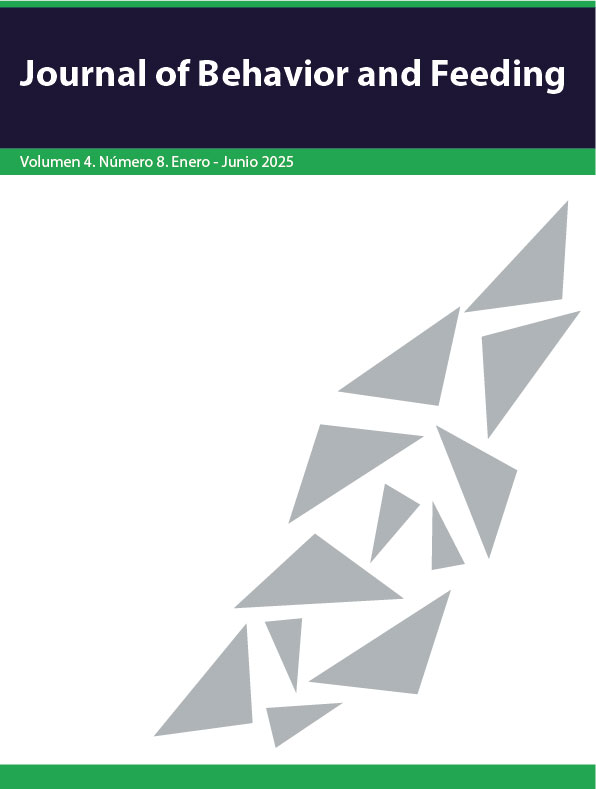Los sentidos y el comportamiento alimentario: Implicaciones de la discapacidad sensorial
DOI:
https://doi.org/10.32870/jbf.v4i8.73Palabras clave:
discapacidad sensorial, comportamiento alimentario, sentidos, procesamiento sensorialResumen
El comportamiento alimentario es un fenómeno complejo que resulta de la interacción de nuestro organismo para hacerle frente al ambiente alimentario que nos rodea o que se podría presentar o no en un tiempo cercano. Es a través de lo que vemos, oímos, tocamos, saboreamos y olemos que podemos captar las señales necesarias para ejecutar conductas públicas o privadas que aseguraran que consigamos responder a necesidades biológicas como el hambre, cumplamos con normas sociales establecidas y no escritas y satisfagamos alguna necesidad emocional. Cuando se compromete alguno de los sentidos, es seguro que tendrá una repercusión en nuestra vida diaria y en cómo nos alimentamos. Este escrito es una perspectiva que pretende dar foco a las implicaciones en el comportamiento alimentario de las personas cuando se vive con una discapacidad sensorial.
Descargas
Citas
Alfaro, R., Doty, T., Narayanan, A., Lugar, H., Hershey, T., y Pepino, M. Y. (2020). Taste and smell function in Wolfram syndrome. Orphanet Journal of Rare Diseases, 15(1), 57. https://doi.org/10.1186/s13023-020-1335-7
Archer, N., Shaw, J., Cochet-Broch, M., Bunch, R., Poelman, A., Barendse, W., y Duesing, K. (2019). Obesity is associated with altered gene expression in human tastebuds. International Journal of Obesity, 43(7), 1475–1484. https://doi.org/10.1038/s41366-018-0303-y
Aristizábal Gómez, K. V. (2021). Cuando hablamos de discapacidad, ¿de qué hablamos? Una revisión teórica y jurídica del concepto. Civilizar Ciencias Sociales y Humanas, 21(40), 59-72. http://www.scielo.org.co/scielo.php?pid=S1657-89532021000100059&script=sci_arttext
Aschenbrenner, K., Hummel, C., Teszmer, K., Krone, F., Ishimaru, T., Seo, H. S., y Hummel, T. (2008). The influence of olfactory loss on dietary behaviors. The Laryngoscope, 118(1), 135-144. https://doi.org/10.1097/MLG.0b013e318155a4b9
Ballco, P., y Gracia, A. (2020). An extended approach combining sensory and real choice experiments to examine new product attributes. Food Quality and Preference, 80, 103830. https://doi.org/10.1016/j.foodqual.2019.103830
Baltes, P. B., y Lindenberger, U. (1997). Emergence of a powerful connection between sensory and cognitive functions across the adult life span: A new window to the study of cognitive aging?. Psychology and Aging, 12(1), 12–21. https://doi.org/10.1037/0882-7974.12.1.12
Bédard, A., Lamarche, P. O., Grégoire, L. M., Trudel-Guy, C., Provencher, V., Desroches, S., y Lemieux, S. (2020). Can eating pleasure be a lever for healthy eating? A systematic scoping review of eating pleasure and its links with dietary behaviors and health. PLOS ONE, 15(12), e0244292. https://journals.plos.org/plosone/article?id=10.1371/journal.pone.0244292
Besnard, P., Passilly-Degrace, P., y Khan, N. A. (2016). Taste of fat: A sixth taste modality? Physiological Reviews, 96(1), 151–176. https://doi.org/10.1152/physrev.00002.2015
Cáceres Rodríguez, C. (2004). Sobre el concepto de discapacidad. Una revisión de las propuestas de la OMS. Audition, 2(3), 74-77. https://doi.org/10.51445/sja.auditio.vol2.2004.0030
Capaldi, E. D. (1996). Conditioned food preferences. En E. D. Capaldi (Ed.). Why we eat what we eat. The psychology of eating (pp. 53-80). American Psichological Association.
Capistrán, R. W. (2024). El desarrollo del oído y la apreciación musical en la educación básica: Algunas reflexiones e ideas pedagógicas. Arte, Entre Paréntesis, 1(18). https://doi.org/10.36797/aep.v1i18.130
De Bruijn, M. J., y Bender, M. (2018). Olfactory cues are more effective than visual cues in experimentally triggering autobiographical memories. Memory, 26(4), 547-558. https://doi.org/10.1080/09658211.2017.1381744
Di Giosia, P., Stamerra, C. A., Giorgini, P., Jamialahamdi, T., Butler, A. E., y Sahebkar, A. (2022). The role of nutrition in inflammaging. Ageing Research Reviews, 77, 101596. https://doi.org/10.1016/j.arr.2022.101596
Foss, D. J., y Swinney, D. A. (1973). On the psychological reality of the phoneme: Perception, identification, and consciousness. Journal of Verbal Learning and Verbal Behavior, 12(3), 246-257. http://citeseerx.ist.psu.edu/viewdoc/download?doi=10.1.1.582.9035&rep=rep1&type=pdf
Instituto de Seguridad y Servicios Sociales de los Trabajadores del Estado (2021). Hablemos de Discapacidad. https://www.gob.mx/issste/articulos/hablemos-de-discapacidad
Jürkenbeck, K., y Spiller, A. (2021). Importance of sensory quality signals in consumers’ food choice. Food Quality and Preference, 90, 104155. https://doi.org/10.1016/j.foodqual.2020.104155
Leitzke, B. T., y Pollak, S. D. (2016). Developmental changes in the primacy of facial cues for emotion recognition. Developmental Psychology, 52(4), 572–581. https://doi.org/10.1037/a0040067
Mainieri, W. L. (2019). Discapacidad o diversidad funcional:¿quién decide?. Autonomía Personal, (24), 34-39. https://www.euskadi.eus/contenidos/documentacion/doc_sosa_diversidad/eu_def/adjuntos/afondo-9-14.pdf
Martin, G. y Pear, J. (2008). Modificación de Conducta. Qué es y Cómo aplicarla. Pearson Prentice Hall.
McCrickerd, K., y Forde, C. G. (2016). Sensory influences on food intake control: moving beyond palatability. Obesity Reviews, 17(1), 18-29. https://doi.org/10.1111/obr.12340
Melguizo, R. C. (2014). Evolución del concepto de discapacidad en la sociedad contemporánea: de cuerpos enfermos a sociedades excluyentes. Praxis Sociológica, (18), 155-175. https://dialnet.unirioja.es/servlet/articulo?codigo=4776246
Morquecho-Campos, P., de Graaf, K., y Boesveldt, S. (2021). Olfactory priming for eating behavior–The influence of non-conscious exposure to food odors on specific appetite, food preferences and intake. Food Quality and Preference, 90, 104156. https://doi.org/10.1016/j.foodqual.2020.104156
Ni, D., Smyth, H. E., Cozzolino, D., y Gidley, M. J. (2022). Integrating effects of human physiology, psychology, and individual variations on satiety-an exploratory study. Frontiers in Nutrition, 9, 872169. https://doi.org/10.3389/fnut.2022.872169
Organización Mundial de la Salud (2021). Hablemos de discapacidad. https://www.gob.mx/issste/articulos/hablemos-de-discapacidad
Organización Mundial de la Salud (2023a). Discapacidad. https://www.who.int/es/news-room/fact-sheets/detail/disability-and-health
Organización Mundial de la Salud (2023b). Ceguera y discapacidad visual. https://www.who.int/es/news-room/fact-sheets/detail/blindness-and-visual-impairment
Piqueras-Fiszman, B., y Spence, C. (2015). Sensory expectations based on product-extrinsic food cues: An interdisciplinary review of the empirical evidence and theoretical accounts. Food Quality and Preference, 40, 165-179. https://doi.org/10.1016/j.foodqual.2014.09.013
Pizarro M., M., Saffery Q., K., y Gajardo O., P. (2022). Trastorno del procesamiento sensorial. Una mirada conjunta desde la terapia ocupacional y la otorrinolaringología. Revista de Otorrinolaringología y Cirugía de Cabeza y Cuello, 82(1), 114-126. https://dx.doi.org/10.4067/s0718-48162022000100114
Powell, D. S., Oh, E. S., Reed, N. S., Lin, F. R., y Deal, J. A. (2022). Hearing loss and cognition: what we know and where we need to go. Frontiers in Aging Neuroscience, 13, 769405. https://www.frontiersin.org/journals/aging-neuroscience/articles/10.3389/fnagi.2021.769405/full
Santacaloma-Suárez, A. M. (2018). Aprendizaje del comer. Una complejidad en la infancia. En A. López-Espinoza (Ed.), Investigaciones en Comportamiento Alimentario Reflexiones, Alcances y Retos (pp. 61-80). Porrúa.
Scott, K. (2005). Taste recognition: Food for thought. Neuron, 48(3), 455–464. https://doi.org/10.1016/j.neuron.2005.10.015
Slade, K., Plack, C. J., y Nuttall, H. E. (2020). The effects of age-related hearing loss on the brain and cognitive function. Trends in Neurosciences, 43(10), 810-821. https://www.cell.com/trends/neurosciences/fulltext/S0166-2236(20)30169-7
Spence, C. (2016). Sound: The forgotten flavor sense. En B. Piqueras-Fiszman y C. Spence (Eds.), Multisensory Flavor Perception (pp. 81-105). Woodhead Publishing. https://doi.org/10.1016/B978-0-08-100350-3.00005-5
Spence, C. (2020). Multisensory flavor perception: A cognitive neuroscience perspective. En K. Sathian y V. S. Ramachandran (Eds.), Multisensory Perception (pp. 221-237). Academic Press. https://doi.org/10.1016/B978-0-12-812492-5.00010-3
Syed, Q., Hendler, K. T., y Koncilja, K. (2016). The impact of aging and medical status on dysgeusia. The American Journal of Medicine, 129(7), 753.e1-753.e6. https://doi.org/10.1016/j.amjmed.2016.02.003
Thapar, A., Cooper, M., y Rutter, M. (2017). Neurodevelopmental disorders. The Lancet Psychiatry, 4(4), 339-346. https://doi.org/10.1016/S2215-0366(16)30376-5
Vadiveloo, M., Principato, L., Morwitz, V., y Mattei, J. (2019). Sensory variety in shape and color influences fruit and vegetable intake, liking, and purchase intentions in some subsets of adults: A randomized pilot experiment. Food Quality and Preference, 71, 301-310. https://doi.org/10.1016/j.foodqual.2018.08.002
Wadhera, D., y Capaldi-Phillips, E. D. (2014). A review of visual cues associated with food on food acceptance and consumption. Eating Behaviors, 15(1), 132-143. https://doi.org/10.1016/j.eatbeh.2013.11.003
Werthmann, J., Jansen, A., Havermans, R., Nederkoorn, C., Kremers, S., y Roefs, A. (2015). Bits and pieces. Food texture influences food acceptance in young children. Appetite, 84, 181-187. https://doi.org/10.1016/j.appet.2014.09.025
Publicado
Cómo citar
Número
Sección
Licencia
Derechos de autor 2025 Autores

Esta obra está bajo una licencia internacional Creative Commons Atribución 4.0.
This is an open-access article distributed under the terms of the Creative Commons Attribution License (CC BY). The use, distribution or reproduction is permitted, provided the original author(s) and the copyright owner(s) are credited and that the original publication in this journal is cited, in accordance with accepted academic practice. No use, distribution or reproduction is permitted which does not comply with these terms.









